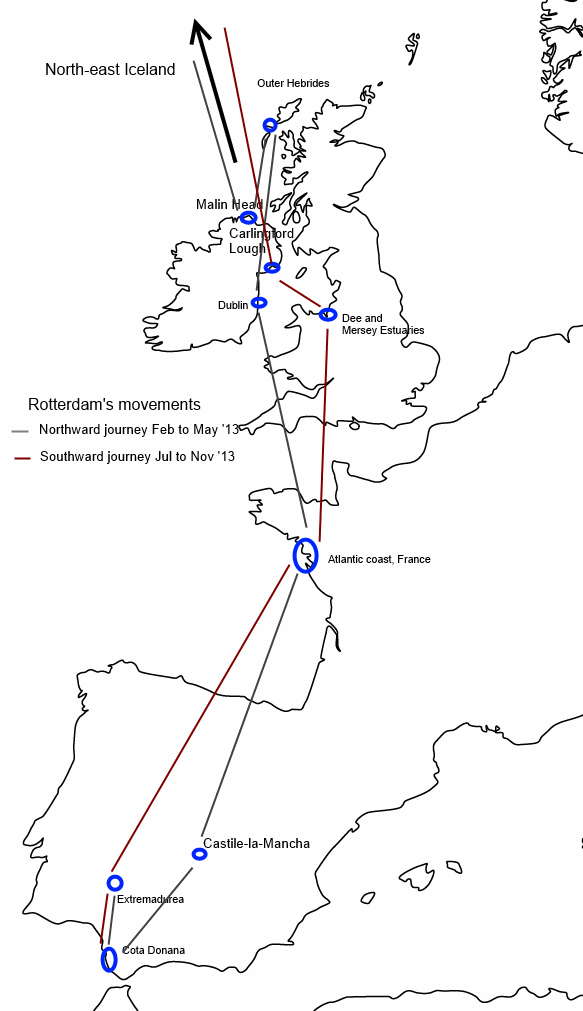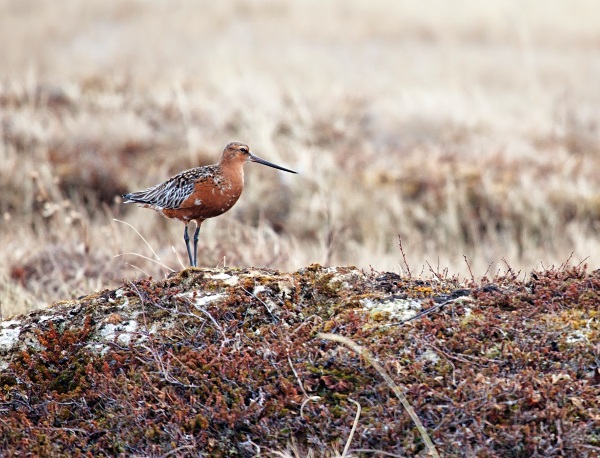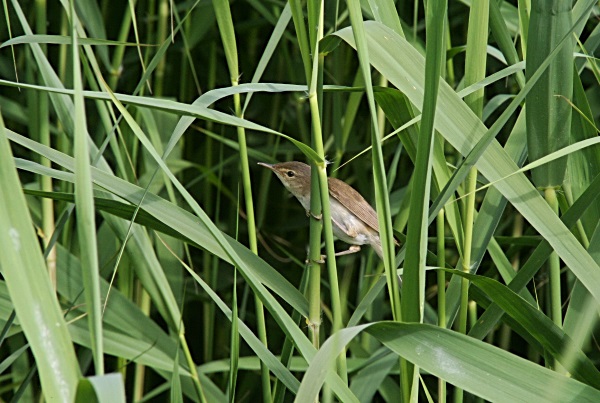Site menu:

July 2014 Newsletter
'Rotterdam' on the Dee Estuary.
Tangled up in Knots 2014.
June Bird News.
Forthcoming Events.
Latest Newsletter.
Rotterdam on the Dee Estuary

You can know the name of a bird in all the languages of the world, but when you've finished, you'll know absolutely nothing whatever about the bird... So let's look at the bird and see what it's doing - that's what counts. I learned very early the difference between knowing the name of something and knowing something.
Richard Feynman
"There's a colour-ringed Sanderling" I shout excitedly, and get the usual looks of incomprehension from the nearby twitchers. I should have known better, it was early September and Hoylake beach was full of Curlew Sandpipers and Little Stints, with always the possibility of something much rarer, and nobody else there had the slightest interest in a colour-ringed Sanderling! But it was of interest to me as it was juvenile and ringed only two months ago as a chick in Greenland. It would provide some very useful data on the survival rates of young birds and their movements for the Sanderling ringing team.
Like those twitchers at Hoylake I suspect that most birders think we small group of colour ringed wader enthusiats on the Dee Estuary are a little bit crazy. But we find it fascinating finding out about the detailed movements of individual birds, but more importantly it provides vital data both for conservation and for ecological science. Most of our records are from colour-ringed Black-tailed Godwits and there have been many peer reviewed scientific articles which have come out of Operation Godwit, some of which are listed below - see Further Reading.
Anyway - I expect you are wondering about the strange title for this article - 'Rotterdam on the Dee Estuary'. 'Rotterdam' is the name given to a satellite tagged (and colour-ringed) Black-tailed Godwit. It was tagged as part of a collaboration between Dutch and Spanish ornithologists studying the Limosa limosa race of Black-tailed Godwits, except that 'Rotterdam' turned out to be a Limosa islandica bird (i.e. the race that breed in Iceland) and it paid us a visit here on the Dee Estuary in 2013. Before going on to describe Rotterdam's movements I would like to quote one of the scientists involved in the Godwit study, Nathan Senner, taken from the 'Godwit Tagging Program' website which I feel is an excellent description of why colour ringed waders hold such a fascination for us.
| "Color ringing a bird is a
very transformational
activity. It gives a bird an (human) identity. With a set of color
rings, we can watch an individual change through time, learn about its
personality, witness its successes and failures. Attaching a satellite
transmitter to a bird only heightens this sense of transformation and
couples it with a sense of intimacy — we can follow a bird’s every
move. Such a feeling of intimacy can give us (the humans) a sense of
comfort at times. “Oh good, ‘Rotterdam’ is still moving around and
appears healthy.” At other times, though, it can give us a sense of
anxiety. That has been the case this past week: Normally this is the
week when godwits begin arriving back in the Netherlands and we thus
expected to start seeing our satellite transmitter-carrying birds
leaving Extremadura, Spain on their northward migration. But day after
day this week, the transmitters kept reporting the same news: The birds
were still right where we had left them in February, feeding in the
rice fields around Santa Amalia. That all changed this morning when we
awoke to the news that our first bird had begun flying north! Our
flagship bird, “Amalia,” began her northward journey last night and, as
of this morning, was still flying north after passing over Pampalona,
Spain! With that news, we went out this morning to drive around our meadow bird study area to see who else might have decided that spring was going to arrive in the Netherlands after all. We were not disappointed. Despite high winds, pelting rain, and dismal temperatures, many new birds had come in over night. Here were White Wagtails. There were Ruffs. And, right in front of us, a flock of Black-tailed Godwits! That flock of godwits held its own nice surprise: 14 color-ringed individuals! Two of those were birds that we had ringed this February in Spain alongside our satellite transmitter birds. Five others were individuals that we had also seen this February in the rice fields of Extremadura. It felt like seeing old friends. There is nothing more exciting as a scientist than being out in the field and getting data after a long stretch when nothing new was happening. Today was one of those days. Now, hopefully, spring comes to greet us and the godwits keep on migrating and arriving and we keep on collecting data. I know that I am ready!" Nathan Senner, |
Movements of Rotterdam from February 2013 to June 2014
Rotterdam was ringed and tagged on February 2nd 2013 in Extremadurea, Spain, along with 11 other Black-tailed Godwits. It turned out that Rotterdam was the only Icelandic bird, all the rest being continental breeders. Satellite tagging allows us to obtain even more detail than colour ringing does and thanks to the wonders of modern technology the movements of Rotterdam are displayed on the grutto volgprogramma website on an almost daily basis. Using that data I have drawn a summary of two journeys undertaken by Rotterdam on the map below, to and from her breeding area in Iceland in 2013.

The journey north was undertaken during that very cold spring of 2013. She left Spain at the end of March and stayed in France until the late date of May 1st. Like many other waders that spring she was held up by the cold weather on the Outer Hebrides for several days. The satellite data indicated that she flew out in to the Atlantic on May 8th before turning back due to strong head winds and ended up in Northern Ireland. She eventually arrived in Iceland on the remarkably late date of May 21st, about a month overdue. Nevertheless, she seems to have bred successfully, not leaving to head back south until the third week in July.
Our ringing data from birds which spend the winter in France, Portugal and Spain have always given us the impression that these birds pass through the Dee Estuary quickly after the breeding season, with most flying quickly through our area in a day or two, usually during either July and August. It came as a surprise, therefore, to see just how leisurely Rotterdam's journey south was! Having spent at least six weeks near Dundalk she then crossed the Irish Sea around mid-September to spend the next six weeks flying to and fro between the Dee and Mersey estuaries. We had long suspected that there was much interchange between the two estuaries, but this was our first concrete evidence. It was interesting that Rotterdam was using the whole of the Mersey Estuary, both north (by Hale) and south (from New Ferry to Ince), much of the Mersey is inaccessible so records from there are relatively rare. During this time we saw Rotterdam three times on Thurstaston Shore and thus we learnt all about the Godwit Tracking Program - it was also very useful for the team for us to ground-truth their satellite data.
Rotterdam headed south from the Dee on November 6th reaching the south-east coast of Brittany on the 11th, where she stayed for 10 days before eventually reaching south-west Spain on November 23rd, staying there until March 11th 2014. Since then she has made the journey north again and after spending about five weeks in France, she reached north-east Iceland on May 7th where she still is as I write this at the end of June 2014.
The grutto volgprogramma (Godwit Tagging Program) team satellite tagged 16 more Black-tailed Godwits in February 2014 and they think, again, that one is of the Icelandic race so we might see it on the Dee Estuary some day. This one is called 'Tirns' and can be followed, along with all the other birds, on the grutto volgprogramma website - http://volg.keningfanegreide.nl/?lang=en.Sources of Information:
Many
thanks to the grutto volgrogramma (Godwit Tagging Program) team for
giving
us
detailed information about Rotterdam and the program generally, in
particular thanks to Nathan Senner and Theunis
Piersma for their help.
See the grutto volgprogramma website
http://volg.keningfanegreide.nl/?lang=en.
As mentioned above there have been many scientific articles written based on the data gathered from the colour-ringed Black-tailed Godwit scheme. One of the latest is:
Alves, J.A., Gunnarsson, T.G., Hayhow, D.B., Appleton, G.F., Potts, P.M., Sutherland, W.J. & Gill, J.A., 2013, Costs, benefits, and fitness consequences of different migratory strategies, Ecology 94 (part 1): 11–17.
A list of several more scientific articles can be seen at:http://www.uea.ac.uk/~b026515/publications.html.
Also see the following articles about
colour-ringed waders published on this website:
1. Chasing
Blackwits - Iceland 2013, Matt Thomas.
2. Black-tailed
Godwits at the 'Caldy Wildfowl Collection' April and May 2013,
August 2013, Richard Smith.
3. Species
Spotlight - Sanderling, April 2013, Richard Smith.
4. Colour
Ringed Black-tailed Godwits Part 3, January 2011, Richard
Smith, also see Part
2 and Part
1.
5. Colour
Ringed Knots, June 2010, Richard Smith.

It has been seen several times around the Dee Estuary, most recently at Burton Mere Wetlands during June 2014.
Richard Smith
Top of Page
Tangled up in Knots - Norway 2014

You will remember Matt Thomas's fascinating article 'Tangled up in Knots' about his visit to northern Norway in May 2012 (see article in September 2012 Newsletter). Matt visited Norway again this last May where he and his colleagues had no less than 442 sightings of 305 different colour-ringed Knots - a remarkable total and hugely important for the continuing study into Knot migration. One of those Knots had been seen at Thurstaston, in February 2010.
Matt describes this latest visit in his blog - From the Muddy Banks of the Dee.
Some more news regarding Knot - we understand that over 630 Knots were colour-ringed in Iceland during their northward migration this spring, so there must be a good chance of seeing some of these back here on the Dee this winter.
June Bird News

The good weather, particularly the lack
of strong winds, means that the Little Tern colony at Gronant are
having a good breeding season - although we won't know just how good
until we are able to count the fledglings later on in July.
There is also some good news to report at the Common Tern colony at
Shotton. You will remember that this large tern colony (c700 pairs)
failed completely in 2009 and they haven't bred successfully since for
reasons not really understood but thought to be related to lack of
available food. This year over 350 birds are breeding and the last I
heard things were going well which is excellent news.

see - http://www.ipernity.com/doc/697571/album/648549
There were a couple of stunning rarities with a Bee-eater first seen and heard over Newton on the 1st and then heard over Middle Eye on the 11th. A Red-necked Phalarope in full summer plumage turned up at Burton Mere Wetlands giving the twitchers great views on the 5th. Also at Burton Mere Wetlands was an immature Little Gull, seen on the 13th, and a Spotted Crake at the end of the month. One or two Quails were heard on Burton Marsh on a couple of dates towards and a juvenile Crossbill in a Meols garden on the 21st was an excellent record.
Other than that things were very quiet with a few returning waders including four Spotted Redshanks and six Little Ringed Plovers at Burton Mere Wetlands, and a few reports of single Common Sandpipers. A, presumably, non-breeding Osprey flew past the reception hide at Burton Mere Wetlands on the 1st. Several Mediterranean Gulls were recorded including three at Heswall on the 26th. A male Redstart in Little Neston on the 8th might indicate a rare nesting nearby.
The Raven is a species which has been doing well locally over the past ten years. They seem to be continuing to increase and a party of 11 over Heswall Marsh this month were probably two family parties, whilst another family party, consisting of five birds, flew past Hilbre on the 25th.Just a bit of late news from May, I
only recently found out that the max count of Whimbrel at Heswall was
156 - an excellent total.
What to expect in July
It is always fascinating to see the build up of waders during the month as they return from breeding. By the month-end there will be many Dunlin, Ringed Plover and Sanderling passing through, among them could be a summer plumaged adult Curlew Sandpiper or two. The flock of Redshanks at Heswall may well be the largest flock in the country at this time of year, although peak numbers are not normally reached until August or September. At fresh water sites Sandpipers will be seen with Common and Green, and hopefully the rarer Wood. Greenshanks and Spotted Redshanks will also be at the same sites and Parkgate Marsh is also a good spot for these.
If we get some strong west winds look out for Storm Petrels out to sea, as well as skuas and Manx Shearwaters. In the inner estuary Little Egrets peak late summer and we had 380 coming into the roost at Burton this time last year, a remarkable spectacle.
July is a month to look out for juvenile birds. Perhaps the easiest to spot will be Sandwich Terns and, if they've had a good breeding season, numbers are usually around 30% of the total; these young birds are often the ones making the most racket! Other species may be less easy to see and some certainly present a nice ID challenge.

Top of Page
Forthcoming Events
July Highest Spring Tides (Liverpool)
Also
see Tides
page.
13th July, 13.18hrs (BST), 9.6m.
14th July, 14.06hrs (BST), 9.6m.
Forthcoming Events
Organised by the Wirral
Ranger Service , Flintshire
Countryside Service and the
RSPB (Dee Estuary):
All these events and walks have bird interest, even those not
advertised specifically for birdwatching. No need to book for these
events unless specified - please check below.
Also see 2014 Events Diary.
Price: £3 suggested donation per person
Booking essential
Join the Coastal Rangers and RSPB for an evening walk across the sands to Hilbre Island to discover its wildlife and history. Warm waterproof clothing, stout footwear or wellingtons are recommended. Bring binoculars if you have them. Places are limited and a suggested donation of £3.00 will be gratefully received on the day.
The island has two compost toilets, but no other amenities. There is ample free parking in West Kirby; the walk to the island is almost 2 miles in each direction, across wet sand and mud.
Booking essential (0151) 648 4371.
Saturday 26th July
The Big Sea Watch:
Join the Coastal Rangers, staff from the RSPB and Hilbre Bird Observatory for a day on Hilbre looking for seabirds, wading birds and cetaceans that inhabit our wonderful coast. We will be staying on Hilbre during high tide giving us the best chance to see them.
Places are limited with a suggested donation of £5:00 for this event.
For more information and to book your place please ring Wirral Country Park on (0151) 648 4371
Friday 15th August 10:00am start
Mud Glorious Mud!
Join the Coastal Rangers and RSPB to find out what lives below our feet on Hoylake beach and learn about the birds that feed on the creatures that we might find! Please be aware that wellingtons are ESSENTIAL for this event and is not suitable for very young children. No need to book - just turn up at the above time. Meet at the Lifeboat Station, King’s Parade, Hoylake.
For further information please ring Wirral Country Park on (0151) 648 4371
Saturday 16th August 6:30pm – 9:30pm
Sunset and Wildlife:
Join the Coastal Rangers and RSPB for an evening walk across the sands to Hilbre Island to discover its wildlife and history. Warm waterproof clothing, stout footwear or wellingtons are recommended. Bring binoculars if you have them.
Places are limited and a suggested donation of £3:00 will be gratefully received for this event.
Booking essential (0151) 648 4371